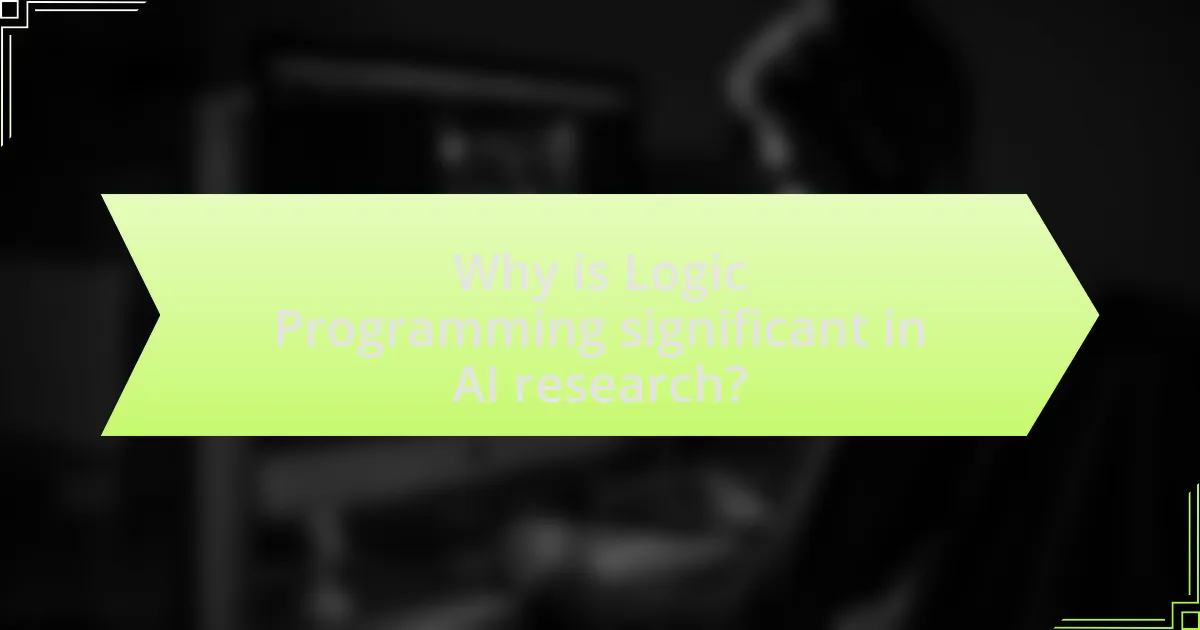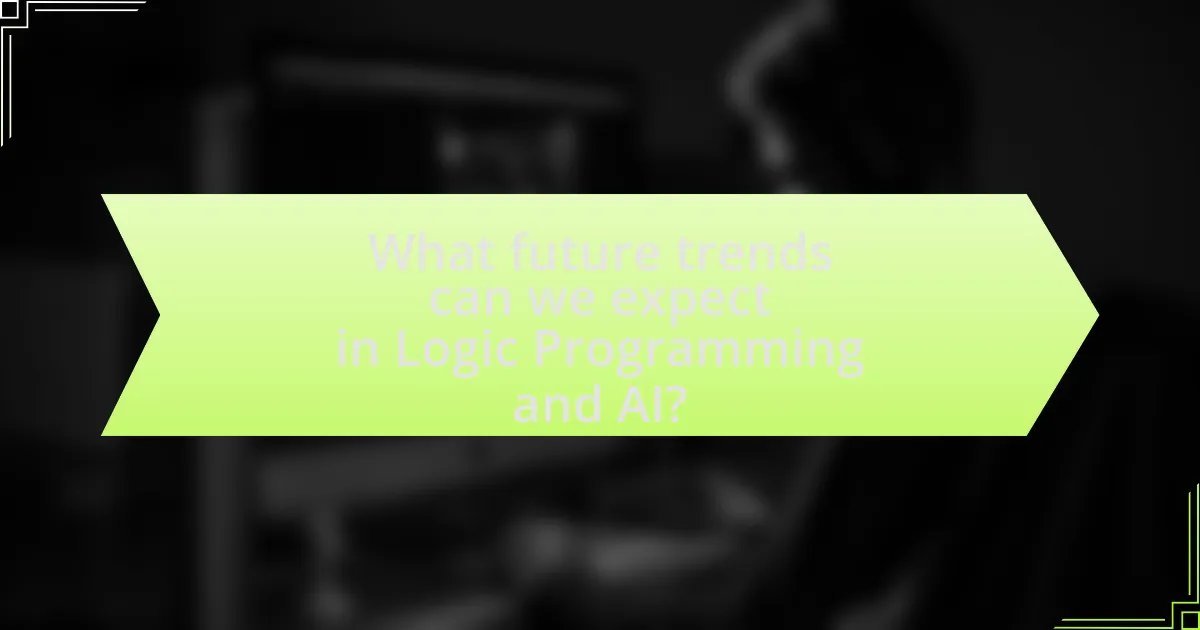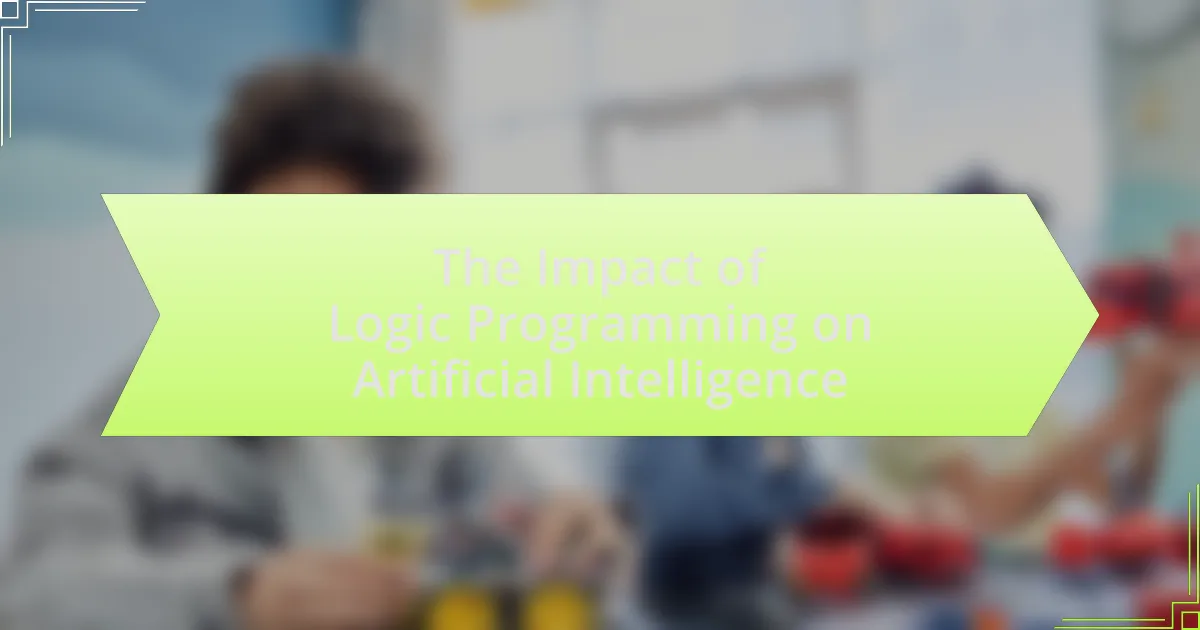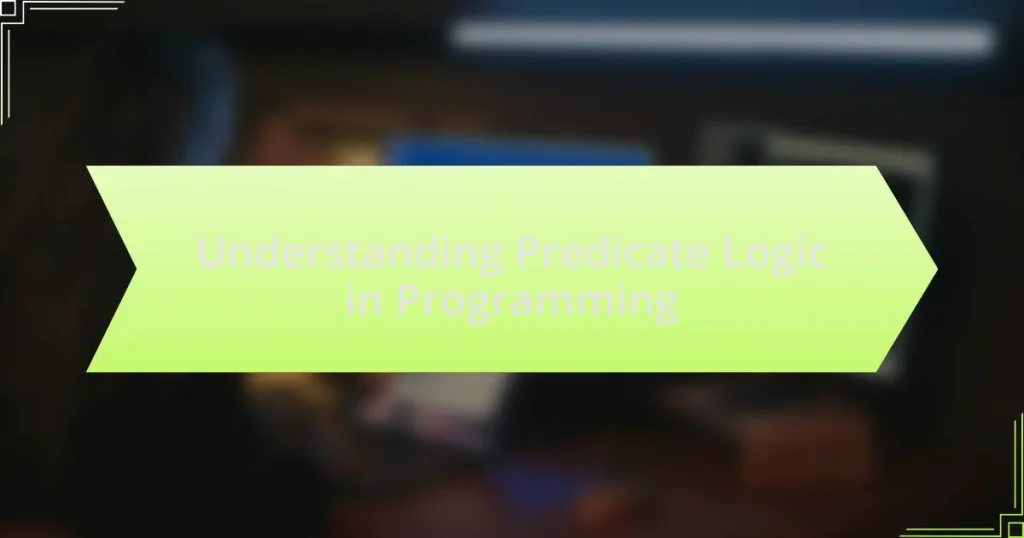Logic programming plays a crucial role in the field of artificial intelligence by providing a formal framework for knowledge representation and automated reasoning. This article explores the impact of logic programming on AI, highlighting its contributions to natural language processing, expert systems, and problem-solving capabilities. Key principles of logic programming, such as the use of formal logic and declarative problem-solving, are discussed, along with its applications and advantages in AI. Additionally, the article addresses the limitations of logic programming, its evolution, and future trends, emphasizing the integration of logic programming with emerging technologies like machine learning.

What is the Impact of Logic Programming on Artificial Intelligence?
Logic programming significantly impacts artificial intelligence by providing a formal framework for knowledge representation and reasoning. This paradigm allows for the expression of complex relationships and rules in a way that machines can process, enabling automated reasoning and problem-solving capabilities. For instance, Prolog, a prominent logic programming language, has been widely used in AI applications such as natural language processing, expert systems, and theorem proving, demonstrating its effectiveness in handling symbolic reasoning tasks. The ability to derive conclusions from a set of premises through logical inference is foundational to many AI systems, enhancing their ability to mimic human-like reasoning.
How does Logic Programming contribute to the development of AI?
Logic programming significantly contributes to the development of AI by providing a formal framework for knowledge representation and automated reasoning. This paradigm allows for the expression of facts and rules in a way that machines can interpret, enabling them to derive conclusions from given information. For instance, Prolog, a prominent logic programming language, facilitates the implementation of algorithms for problem-solving and natural language processing, which are essential in AI applications. The effectiveness of logic programming in AI is evidenced by its use in expert systems, where it helps in decision-making processes by simulating human reasoning through logical inference.
What are the fundamental principles of Logic Programming?
The fundamental principles of Logic Programming include the use of formal logic as a programming paradigm, where programs are expressed in terms of relations and rules. Logic Programming is based on the concepts of facts, rules, and queries, allowing for declarative problem-solving. The primary proof of its effectiveness is seen in languages like Prolog, which utilize these principles to facilitate automated reasoning and knowledge representation, demonstrating its significant impact on fields such as artificial intelligence and computational linguistics.
How does Logic Programming differ from other programming paradigms in AI?
Logic programming differs from other programming paradigms in AI by emphasizing formal logic as a primary means of knowledge representation and problem-solving. In contrast to imperative programming, which focuses on how to perform tasks through sequences of commands, logic programming allows for the declaration of facts and rules, enabling the system to infer conclusions through logical reasoning. This paradigm is exemplified by languages such as Prolog, where the programmer specifies relationships and constraints, and the logic engine derives solutions based on these specifications. The declarative nature of logic programming facilitates easier reasoning about complex problems, making it particularly effective for applications in natural language processing, theorem proving, and expert systems, where the relationships between data points are crucial.
What are the key applications of Logic Programming in AI?
The key applications of Logic Programming in AI include knowledge representation, automated reasoning, and natural language processing. Knowledge representation allows for the encoding of facts and rules about the world in a formal way, enabling systems to infer new information. Automated reasoning utilizes logical inference to derive conclusions from known facts, which is essential in expert systems and decision-making applications. In natural language processing, Logic Programming facilitates the understanding and generation of human language through formal grammars and semantic representations. These applications demonstrate the effectiveness of Logic Programming in creating intelligent systems that can reason, learn, and communicate.
How is Logic Programming used in natural language processing?
Logic programming is utilized in natural language processing (NLP) primarily for tasks involving knowledge representation, reasoning, and understanding linguistic structures. It enables the formalization of grammar rules and semantic interpretations, allowing systems to parse and generate human language effectively. For instance, Prolog, a logic programming language, is often employed to implement natural language parsers that can deduce meanings from sentences based on defined logical rules. This approach has been validated in various studies, such as “Logic Programming for Natural Language Processing” by Pereira and Shieber, which demonstrates how logic-based frameworks can enhance the accuracy of syntactic and semantic analysis in NLP applications.
What role does Logic Programming play in expert systems?
Logic programming serves as a foundational framework for expert systems by enabling the representation of knowledge in a formal, logical manner. This approach allows expert systems to utilize rules and facts to infer conclusions and make decisions based on logical reasoning. For instance, Prolog, a prominent logic programming language, facilitates the development of expert systems by allowing developers to define relationships and rules that govern the behavior of the system. The effectiveness of logic programming in expert systems is evidenced by its ability to handle complex problem-solving tasks, as seen in applications like medical diagnosis systems, where logical rules can represent symptoms and diagnoses, leading to accurate conclusions based on the input data.

Why is Logic Programming significant in AI research?
Logic programming is significant in AI research because it provides a formal framework for representing knowledge and reasoning about it. This paradigm allows for the creation of systems that can infer new information from existing facts through logical deduction, which is essential for tasks such as automated theorem proving and natural language understanding. The use of languages like Prolog exemplifies this significance, as they enable the expression of complex relationships and rules in a concise manner, facilitating the development of intelligent systems that can solve problems in various domains, including robotics and expert systems.
What advantages does Logic Programming offer for AI problem-solving?
Logic Programming offers several advantages for AI problem-solving, primarily through its declarative nature, which allows for clear expression of logic and relationships. This approach enables developers to focus on what the problem is rather than how to solve it, facilitating easier reasoning and problem formulation. Additionally, Logic Programming supports automated reasoning, allowing systems to derive conclusions from given facts and rules efficiently. For instance, Prolog, a prominent Logic Programming language, has been successfully used in various AI applications, including natural language processing and expert systems, demonstrating its effectiveness in handling complex problem-solving tasks.
How does Logic Programming enhance reasoning capabilities in AI?
Logic programming enhances reasoning capabilities in AI by providing a formal framework for representing knowledge and deriving conclusions through logical inference. This paradigm allows AI systems to express complex relationships and rules in a declarative manner, enabling them to reason about data and make decisions based on logical deductions. For instance, Prolog, a prominent logic programming language, utilizes a resolution-based inference mechanism that systematically applies logical rules to derive new information from existing facts. This capability is evidenced by applications in expert systems and automated theorem proving, where logic programming has been successfully employed to solve complex problems by simulating human-like reasoning processes.
What are the limitations of Logic Programming in AI applications?
Logic programming has several limitations in AI applications, primarily its inefficiency in handling large-scale problems and its reliance on complete knowledge. Logic programming systems, such as Prolog, struggle with performance when faced with complex queries or extensive datasets, as they often require exhaustive search methods that can lead to significant computational overhead. Additionally, logic programming assumes that all relevant information is known and can be expressed in logical terms, which is rarely the case in real-world scenarios where uncertainty and incomplete knowledge are prevalent. This limitation restricts its applicability in dynamic environments where adaptability and learning from incomplete data are crucial for effective AI solutions.
How has Logic Programming evolved in the context of AI?
Logic programming has evolved significantly in the context of AI, transitioning from foundational theories to practical applications. Initially, logic programming, exemplified by languages like Prolog, was primarily used for symbolic reasoning and knowledge representation in AI systems. Over time, advancements in computational power and algorithmic efficiency have enabled more complex problem-solving capabilities, allowing logic programming to integrate with other paradigms such as machine learning and constraint satisfaction.
For instance, the introduction of Answer Set Programming (ASP) has expanded the scope of logic programming by facilitating non-monotonic reasoning, which is crucial for handling uncertainty in AI applications. Additionally, the combination of logic programming with neural networks has led to the development of neuro-symbolic systems, enhancing the interpretability of AI models while maintaining their learning capabilities. This evolution reflects a broader trend in AI towards hybrid approaches that leverage the strengths of various methodologies, demonstrating the enduring relevance of logic programming in contemporary AI research and applications.
What historical milestones have shaped Logic Programming’s role in AI?
The development of Logic Programming has been significantly shaped by several historical milestones that established its role in Artificial Intelligence. The introduction of Prolog in the early 1970s by Alain Colmerauer and his team marked a pivotal moment, as it provided a practical implementation of logic-based programming that facilitated AI research and applications. In 1972, the first Prolog interpreter was created, enabling the use of logical rules for problem-solving and knowledge representation.
Another key milestone was the publication of “The Art of Prolog” in 1990 by Leon Sterling and Ehud Shapiro, which solidified Prolog’s theoretical foundations and practical applications in AI, influencing both academic and industrial sectors. The establishment of the Association for Logic Programming in 1986 further promoted research and collaboration in the field, leading to advancements in logic-based AI systems.
Additionally, the integration of logic programming with other paradigms, such as constraint logic programming in the late 1980s, expanded its applicability in AI, particularly in areas like scheduling and resource allocation. These milestones collectively underscore the evolution of Logic Programming as a foundational element in the development of intelligent systems.
How have advancements in Logic Programming influenced AI methodologies?
Advancements in Logic Programming have significantly influenced AI methodologies by enhancing reasoning capabilities and enabling more sophisticated problem-solving techniques. Logic Programming, particularly through languages like Prolog, allows for the representation of knowledge in a formal way, facilitating automated reasoning and inference. This has led to the development of expert systems and knowledge-based systems that can mimic human decision-making processes. For instance, the use of logic-based frameworks in AI has improved natural language processing and machine learning algorithms, as seen in systems that utilize logical rules for data interpretation and decision-making. These advancements have been pivotal in creating systems that can learn from data while maintaining a clear structure for reasoning, thereby increasing the efficiency and effectiveness of AI applications across various domains.

What future trends can we expect in Logic Programming and AI?
Future trends in Logic Programming and AI include increased integration of logic-based reasoning in machine learning models, enhanced capabilities for automated theorem proving, and the development of more sophisticated knowledge representation systems. These trends are driven by the need for AI systems to handle complex reasoning tasks and interpret vast amounts of data effectively. For instance, advancements in neural-symbolic integration are enabling AI to combine the strengths of neural networks with the rigorous reasoning capabilities of logic programming, as evidenced by research from the University of Oxford, which highlights the potential for improved interpretability and reliability in AI systems. Additionally, the rise of explainable AI emphasizes the importance of logic programming in providing transparent decision-making processes, further solidifying its role in the future landscape of artificial intelligence.
How might Logic Programming adapt to emerging AI technologies?
Logic Programming may adapt to emerging AI technologies by integrating with machine learning frameworks to enhance reasoning capabilities. This integration allows Logic Programming to leverage data-driven insights while maintaining its strong foundation in formal logic. For instance, systems like Prolog can be combined with neural networks to create hybrid models that utilize both symbolic reasoning and statistical learning, improving decision-making processes in complex AI applications. Research has shown that such hybrid approaches can outperform traditional methods in tasks requiring both logical inference and pattern recognition, demonstrating the potential for Logic Programming to evolve alongside advancements in AI.
What potential innovations could arise from integrating Logic Programming with machine learning?
Integrating Logic Programming with machine learning could lead to innovations such as enhanced explainability in AI models and improved reasoning capabilities. Logic Programming provides a formal framework for representing knowledge and rules, which can complement the statistical nature of machine learning. For instance, combining these approaches can enable models to not only make predictions but also justify their decisions based on logical rules, thereby increasing transparency. Research has shown that systems like Neuro-Symbolic AI, which merge neural networks with symbolic reasoning, can achieve better performance on tasks requiring both learning from data and reasoning about that data, as evidenced by projects from MIT and Stanford.
What best practices should be followed when using Logic Programming in AI?
When using Logic Programming in AI, best practices include ensuring clarity in the representation of knowledge, optimizing the efficiency of queries, and maintaining modularity in code design. Clarity in knowledge representation allows for easier understanding and debugging of logic rules, which is crucial for effective AI systems. Optimizing query efficiency minimizes computational overhead, enhancing performance, especially in large datasets. Maintaining modularity in code design facilitates easier updates and testing, promoting better collaboration among developers. These practices are supported by the fact that well-structured logic programs lead to more reliable and maintainable AI applications, as evidenced by successful implementations in expert systems and automated reasoning tasks.
How can developers effectively implement Logic Programming in AI projects?
Developers can effectively implement Logic Programming in AI projects by utilizing languages such as Prolog, which is specifically designed for this paradigm. Logic Programming allows developers to express knowledge in a formal way, enabling the creation of intelligent systems that can reason and infer new information from existing data. For instance, Prolog’s backtracking mechanism facilitates the exploration of possible solutions to complex problems, making it suitable for applications like natural language processing and expert systems. The effectiveness of Logic Programming in AI is evidenced by its successful use in projects like the development of the SWI-Prolog system, which has been widely adopted in academic and industrial settings for its robust capabilities in handling logical queries and knowledge representation.
What common challenges should be anticipated when applying Logic Programming in AI?
Common challenges when applying Logic Programming in AI include scalability issues, difficulty in handling uncertainty, and performance limitations. Scalability problems arise because logic-based systems can struggle with large datasets, leading to increased computational complexity. Additionally, Logic Programming typically operates under deterministic assumptions, making it challenging to incorporate probabilistic reasoning, which is essential for dealing with real-world uncertainty. Performance limitations are evident as the inference mechanisms in Logic Programming can be slower compared to other paradigms, particularly in dynamic environments where rapid decision-making is required. These challenges highlight the need for ongoing research and development to enhance the applicability of Logic Programming in AI contexts.



